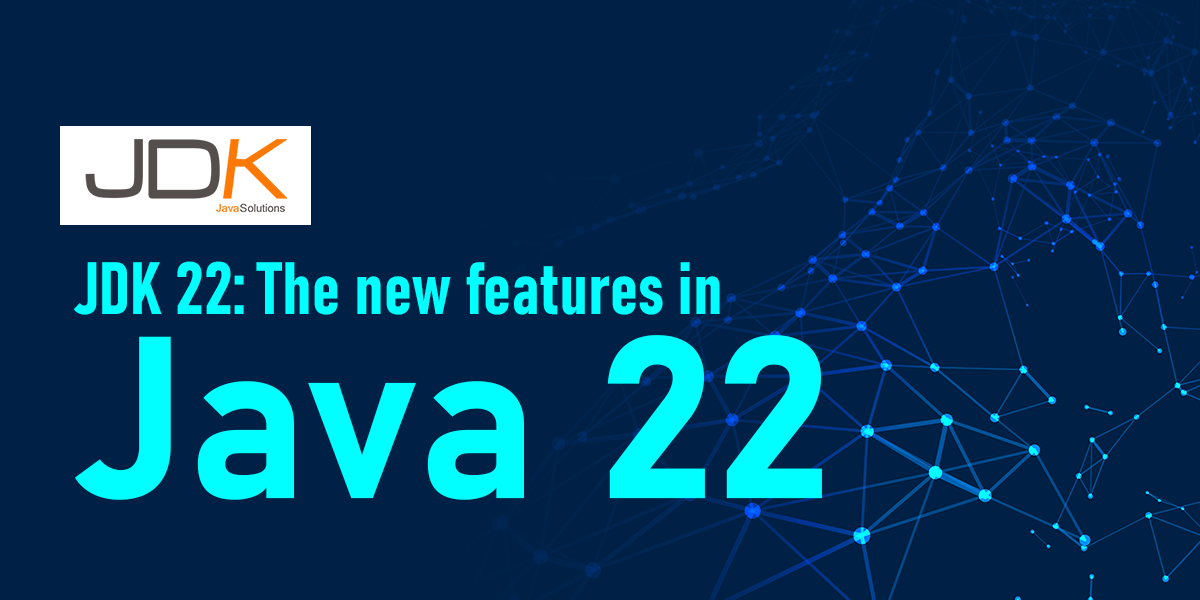Exploring the Exciting Features of JDK 22

Data Scientist
Deep learning and machine learning specialist, well-versed with experience in Cloud infrastructure, Block-chain technologies, and Big Data solutions.
February 06, 2024

Introduction:
Java, the versatile and widely-used programming language, continues to evolve with each new release of the Java Development Kit (JDK). With the arrival of JDK 22, developers are in for a treat as this release introduces several exciting features and enhancements. In this comprehensive guide, we will delve into the key additions that make JDK 22 a noteworthy update.
1. Pattern Matching for Switch (JEP 428):
One of the headline features of JDK 22 is the enhancement to pattern matching with the introduction of JEP 428. Pattern Matching for Switch builds upon the previous pattern matching capabilities in Java by allowing developers to use patterns in switch statements. This not only makes code more concise but also improves readability. The update enables developers to express complex conditions more elegantly and is a significant step towards making Java code more expressive and less error-prone.
2. Vector API (Incubator) (JEP 471):
JDK 22 brings the Vector API as an incubator module (JEP 471), aimed at improving the performance of numerical computations. The Vector API introduces a set of vectorized operations to perform computations on vectors of numerical data, taking advantage of hardware capabilities like SIMD (Single Instruction, Multiple Data). Developers can leverage this API to write high-performance code for mathematical operations, making Java more competitive in the field of numerical computing.
3. Foreign Function and Memory API (Incubator) (JEP 389):
Another notable addition in JDK 22 is the Foreign Function and Memory API, introduced as an incubator module (JEP 389). This API allows Java programs to interoperate with native code and memory more efficiently. Developers can now call native functions directly from Java and work with native memory using a safer and more convenient API. This is a significant step forward for developers working on projects that require integration with native libraries and low-level system interactions.
4. New macOS Rendering Pipeline (JEP 394):
JDK 22 brings improvements to the rendering pipeline on macOS with the introduction of a new Metal-based rendering pipeline (JEP 394). This update aims to enhance the graphics performance and provide a smoother user experience for Java applications on macOS. With the adoption of Metal, Java applications can take advantage of modern graphics capabilities and ensure better compatibility with the latest macOS versions.
5. New macOS/AArch64 Port (JEP 442):
In addition to the new rendering pipeline, JDK 22 introduces a new macOS/AArch64 port (JEP 442). This means that Java applications can now run natively on Apple Silicon-based Macs, taking advantage of the architecture's performance improvements. This update ensures that Java remains a first-class citizen on the macOS platform and provides a seamless experience for developers and end-users on the latest hardware.
6. Project Loom (Incubator) (JEP 376):
Project Loom, an incubator feature introduced in JDK 22 (JEP 376), aims to simplify concurrency in Java with the introduction of lightweight, user-mode threads known as fibers. Fibers offer a more efficient and scalable alternative to traditional threads, making it easier for developers to write concurrent code without the complexities of managing threads directly. This feature is expected to have a significant impact on the way Java developers approach concurrent programming.
7. Performance and Stability Improvements:
As with every JDK release, JDK 22 includes various performance and stability improvements. These enhancements may not be as flashy as new features, but they play a crucial role in ensuring that Java applications run smoothly and efficiently. Developers can benefit from improved runtime performance, reduced memory consumption, and better overall stability when using JDK 22.
8. Records Enhancements (JEP 431):
Building on the introduction of records in Java 16, JDK 22 brings further enhancements to this feature with JEP 431. Records provide a concise way to model immutable data in Java. With the new enhancements, developers can now explicitly declare constructors and instance methods within records. This makes records even more versatile, allowing developers to encapsulate behavior within these compact and expressive data structures.
9. Deprecation of Security Manager for Removal (JEP 411):
JDK 22 marks the deprecation of the Security Manager and its associated API with the intention of removing it in a future release (JEP 411). The Security Manager, a legacy feature for controlling the execution of untrusted code, has become less relevant in modern applications. Its deprecation signals a shift towards more contemporary security practices, and developers are encouraged to explore alternative security mechanisms.
10. New Garbage Collector Interface (JEP 429):
JDK 22 introduces a new experimental garbage collector interface (JEP 429) that allows developers to implement and plug in their own garbage collectors. While this feature is still in the early stages of development and marked as experimental, it opens the door for innovation in garbage collection strategies. Developers can experiment with custom garbage collectors tailored to specific application requirements, potentially leading to improvements in memory management.
11. Concurrent Thread-Stack Processing (JEP 432):
The new concurrent thread-stack processing feature (JEP 432) aims to improve the responsiveness of the HotSpot JVM during Full GC pauses. By moving the processing of thread stacks from the Full GC phase to a concurrent phase, JDK 22 reduces the impact on application responsiveness during garbage collection. This enhancement contributes to a more fluid user experience in applications with large heaps.
12. Enhanced Null Handling (JEP 421):
JDK 22 introduces enhancements to null handling with the introduction of JEP 421. This improvement focuses on providing more informative error messages when a Null Pointer Exception occurs. Developers will benefit from clearer and more detailed diagnostics, aiding in the identification and resolution of null-related issues during development and debugging.
13. Deprecation of Applet API (JEP 394):
Continuing the trend of removing deprecated and obsolete features, JDK 22 deprecates the Applet API (JEP 394). Applets, once a popular way to deploy Java applications in web browsers, have become obsolete with the advancement of web technologies. Developers are encouraged to migrate away from the Applet API and adopt more modern deployment options for web-based Java applications.
14. Project Panama Progress (Incubator):
While not yet a fully realized feature in JDK 22, Project Panama continues to make progress as an incubator project. Project Panama aims to improve the connection between Java and native code, making it more efficient and flexible. It includes features such as the Foreign Function and Memory API (JEP 389) mentioned earlier, and developers can expect further enhancements in future releases, contributing to better integration with native libraries and improved performance in interoperability scenarios.
15. Enhanced JEP Process (JEP 425):
JDK 22 brings improvements to the JDK Enhancement-Proposal & Roadmap Process (JEP) itself with JEP 425. This enhancement focuses on refining the process for proposing, reviewing, and tracking JDK enhancements. By streamlining the process, the Java community can expect more transparency and efficiency in how new features and changes are proposed, discussed, and eventually integrated into the JDK.
16. Java Flight Recorder (JFR) Event Streaming (JEP 364):
JEP 364 introduces Java Flight Recorder (JFR) Event Streaming, providing a more flexible and efficient way to consume JFR data. This enhancement allows developers to stream JFR events in real-time, enabling better monitoring and analysis of Java applications. With this improvement, developers can build more sophisticated tools and integration's to gain deeper insights into the performance and behavior of their applications.
17. JEP 436: Promptly Return Unused Committed Memory from G1:
JDK 22 includes improvements in the Garbage-First (G1) garbage collector with JEP 436. This enhancement aims to reduce memory waste by promptly returning unused committed memory to the operating system. By doing so, G1 becomes more efficient in managing memory resources, especially in scenarios where memory requirements fluctuate over time.
18. Enhancements to the AArch64 Port (JEP 432):
The JDK 22 release includes several enhancements to the AArch64 (ARM 64-bit) port (JEP 432). These improvements focus on optimizing the performance of Java applications on AArch64 architecture, making Java a more attractive choice for developers working on platforms utilizing ARM-based processors, such as mobile devices and embedded systems.
19. JEP 441: Deprecate the RMI Activation System:
The RMI (Remote Method Invocation) Activation System, a part of the Java Remote Method Invocation API, is deprecated in JDK 22 (JEP 441). Developers are encouraged to migrate away from this feature, which has become obsolete over time. This deprecation aligns with the ongoing effort to streamline and remove outdated components from the Java platform.
20. Preview Features:
JDK 22 continues to support and enhance preview features introduced in previous releases. Developers can explore and provide feedback on features like sealed classes and interfaces, pattern matching for switch, and more. Preview features allow developers to experiment with upcoming language changes and provide valuable input before they become standard features.
Conclusion:
JDK 22 is a feature-rich release that goes beyond introducing new functionalities; it refines existing features, improves the development process, and prepares the Java platform for future innovations. From performance optimizations to enhanced tooling support, JDK 22 empowers developers to build robust, efficient, and maintainable Java applications. Staying true to its commitment to backward compatibility, JDK 22 provides a smooth transition for developers while embracing modern paradigms and technologies. As the Java ecosystem continues to evolve, JDK 22 stands as a testament to the collaborative efforts of the Java community in shaping the future of the language.













